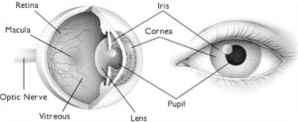Normal Eye Anatomy
The function of our eyes is to enable us to see clearly the objects in our surroundings at variable distances and under various conditions of lights. This function is achieved by a very complex arrangement of structures in the eye.
Parts of the eye:
- Cornea: The transparent front window of the eye. The cornea transmits and focuses light into the eye.
- Iris:The coloured part of the eye. The iris helps regulate the amount of light that enters the eye.
- Pupil:The dark hole in the middle of the iris. The pupil changes size in response to various degrees of illumination to control the amount of light that is let into the eye.
- Lens: The transparent structure behind the iris that focuses light rays onto the retina.
- Retina:The nerve layer that lines the back of the eye. The retina senses light and creates impulses that are sent through the optic nerve to the brain.
- Macula: A small specialized area in the central retina that contains special light sensitive cells. The macula allows us to see fine details clearly.
- Optic Nerve: The nerve that connects the eye to the brain. It carries the impulses formed by the retina to the brain, where it is interpreted as images.
- Vitreous: The clear, jelly-like substance that fills the middle of the eye.

Our eye can be thought of as a very advanced camera. There are many similarities between our eye and a camera. Like in a camera the aim is to provide a well-focused image of the object onto the film at the back of the camera.The normal human eye works to focus or "Refract" light emitted from objects onto the retina.
The light rays first pass through the clear front window of the eye called the CORNEA. The light then passes through the PUPIL, which is an opening created by the IRIS or colored part of the eye. Next, the light passes through the LENS and finally arrives at the RETINA. When these light rays are clearly focused on the retina the result is a clear visual image. The image is formed there and then the signal is sent from there to our brain through the optic nerve, and thus we perceive the objects around us.
For more information on how the eye focuses, and refractive errors, such as Myopia, Hyperopia, Astigmatism, and Presbyopia, click here.

